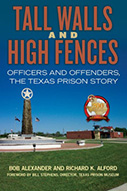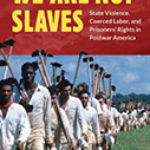Tall Walls And High Fences: Officers And Offenders, The Texas Prison Story

Authors: Bob Alexander and Richard K. Alford
Publisher: Denton, TX: University of North Texas Press. 2020. 562 p.
Reviewer: Paul N. Spellman | February 2021
Two recent publications provide very different perspectives on the history and development of the Texas carceral system. The first, Robert Chase’s We Are Not Slaves: State Violence, Coerced Labor, and Prisoners’ Rights in Postwar America is a rare look at prison conditions and organized activism as told by those held in custody. It is part of the Justice, Power, and Politics series co-edited by historian Heather Ann Thompson, author of Blood in the Water: The Attica Prison Uprising of 1971 and Its Legacy. The second book, Tall Walls and High Fences: Officers and Offenders, the Texas Prison Story, is authored by a retired U. S. Treasury special agent and a career employee of the Texas correctional system.
In 1968, David Resendez Ruiz entered a Texas prison for armed robbery, this time sentenced to 25 years. The 26-year-old son of migrant workers had spent most of his life incarcerated: at the Gatesville Reformatory for Boys, the Ramsey Farm prison, and now the Ellis Unit of the Texas Department of Corrections (TDC). His reputation for violence, including stabbings within the prison walls, was well known throughout the Texas penitentiary system, as was his particular hatred for BTs, or building tenders, “those prisoners who did the officers’ dirty work.” Ruiz become a writ writer, producing legal claims and lawsuits that, among other conditions in the penitentiary system, challenged the dreaded “BTs.” With the aid and encouragement of attorney Frances Jalet, Ruiz’s petition objecting to the conditions of incarceration, including the use of prisoners as guards over other prisoners, generated the class action suit Ruiz v. Estelle. Judge William Wayne Justice’s 1979 ruling declared that conditions of imprisonment in the TDC constituted cruel and unusual punishment in violation of the US Constitution, initiating the most expansive–though not entirely successful–criminal justice reforms in the state’s history. Of even greater import, perhaps, is that the case became one of the most significant lawsuits pertaining to penal conditions in the United States.
The issues raised in the Ruiz v. Estelle case form the thematic center of Chase’s history of prison protests and reform, We Are Not Slaves. Ruiz “fundamentally dismantled the southern model” but led, in Chase’s narrative, to a building boom of new, militarized prisons across the state. Ten chapters divided into three distinct sections lay out a deep social history of the power dynamics within the Texas prison system, from the perspective of those held in custody. Chase describes the struggle to change prison conditions from within, grounding his research in three decades of “testimonies, letters, affidavits, depositions” and 100 oral histories (60 by the author and 40 others archived and in private collections) of prisoners desperate to expose the prison economy to public view. Their stories constitute the history of a southern prisoners’ rights movement in the tradition of labor organizing and civil rights mobilization.
The first section, “A Biography of State Violence and Coerced Labor,” tracks the evolution of the 1940s prison farm system through to the theoretically progressive, but still horrific agricultural enterprise system of the 1970s. The author draws on labor and civil rights histories and reform politics in the United States to explain how the horrors of the Texas southern prison plantations, with its open dorms, transitioned in the 1940s into celled penitentiaries with disastrous results. In imitating northern prison designs, the “reforms” succeeded in both exacerbating preferential and racially delineated labor divisions and hierarchies, and in concealing ongoing state-sanctioned sexual violence and physical abuse.
“Resistance,” the second section, follows a new prototypical prisoner of the 1960s, Fred Cruz, as he transforms from a troublemaker to a keen observer who provides legal documentation of the travails inside prison walls, contributing to a “collective resistance” whose cry was finally heard in the Ruiz case. Chase considers, too, how imprisoned urban Mexican Americans and African Americans forced to labor on southern rural plantations had likely witnessed and been shaped by the multiple urban social protests of the 1960s and 1970s. In the Texas prison, these Brown and Black men formed coalitions to protest their position as “slaves of the state” and to make known the conditions inside. Positioning their cause within the interconnected demands of civil rights, Black Power and the Chicano movement Chase demonstrates how similarly oppressed groups initiated a prison-made civil rights revolution and labor protest movement. In a summary statement Chases writes: “Cruz and Jalet’s shared legacy gave voice to the previously voiceless prisoners whose situation was dire but largely unknown by the wider public…Over the course of the 1970s, [their] legal struggles inspired a prisoners’ rights movement that spread across the prison system like wildfire.” (p.215).
The final section, “Collapse of the Prison Plantation and the Carceral Phoenix” is built around David Ruiz’s story and chronicles the transformation of the (TDC) system and “the refashioning of mass incarceration” into militarized prisons. Acknowledging the critique that the reform movement may have contributed to the equally barbaric gang system that developed in the prisons in the 1980s, Chase contends “that the gangs did not simply evolve in a power vacuum due to an interruption of social order but rather that the ‘social order’ of prisons, whether directed by the state or by the prisoners themselves, is upheld through the persistence of carceral violence.” (p. 388). Although the TDC continued to be a place of systemic violence and brutality, the efforts of Fred Cruz, David Ruiz, and Frances Jalet were not in vain.
Assuming a perspective counter to Chase’s history is that of Alexander and Alford’s Tall Walls and High Fences: Officers and Offenders, the Texas Prison Story, which in a broad historical review of the Texas prison system focuses in on the strengths of the prison officials, correctional officers, and staff who over many decades have dealt with the struggles inherent in an institution of incarceration, particularly the understaffed TDC.
Alexander has written extensively on criminal justice on the American and Texas Frontier and his co-author Alford served thirty-three years in the Texas correctional system, rising from building major and assistant warden to a regional director supervising 15 separate prison units. Combining their research and professional experiences the authors employ a storytelling style to produce an anecdotal overview of the Texas prison system’s evolution from the era of Reconstruction to the present day. Twelve chapters review the significant events and political shifts that shaped the Texas prison system from its earliest times to the present day,
The manuscript concentrates primarily on the internal workings of the system itself and the correctional staff working within that system, from kitchen staff to warden to unit supervisor. Retired TDCJ-CID Director Bill Stephens, in his Foreword, writes: “There is a sector of the public that stereotypes the Correctional Officer as an uneducated, tobacco chewing, redneck guard. [Rather], they are the true heroes. Their attention to duty, compassion for humanity and more importantly strength to ‘do the right thing,’ even when challenged in extremely dangerous circumstances, is what deserves recognition.” (xii) That danger has all too often resulted in the deaths of dozens of prison employees over the many generations, and the book closes with a memoriam of their names. Alexander poses that “behind the tall walls and inside the high fences exists a different and unfamiliar world, one that would be scary and strange to the majority of everyday Texas working folks, those having not a clue about convicted lawbreakers and/or their custodial superintendents.” (xxv) Through carefully constructed anecdotes and often graphic example comes a remarkable and balanced picture of the world of the correctional system from both the prisoner’s view and that of the officials who oversee that constantly changing system.
Together the two books offer the reader a compelling story of two sides of a brutal carceral system.
Paul N Spellman, PhD, is Piper Professor of History at Wharton County Junior College in Richmond, Texas, and the author of several books on Texas Studies.


